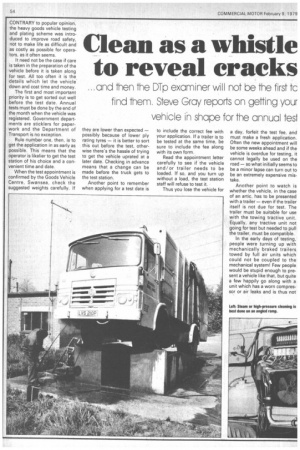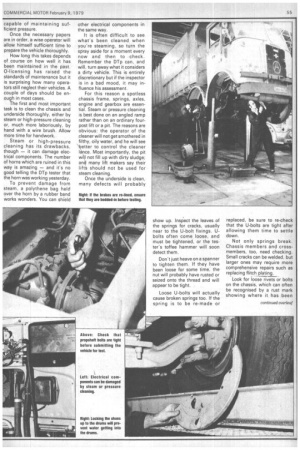lean as a whistle to reveal cracks
Page 56

Page 57

Page 58

If you've noticed an error in this article please click here to report it so we can fix it.
.. and then the Dip examiner will not be the first tc find them. Steve Gray repairs on ceffing your vehicle in shape for the annual tes1
CONTRARY to popular opinion, the heavy goods vehicle testing and plating scheme was introduced to improve road safety, not to make life as difficult and as costly as possible for operators, as it often seems.
It need not be the case if care is taken in the preparation of the vehicle before it is taken along for test. All too often it is the details which let the vehicle down and cost time and money.
The first and most important priority is to get sorted out well before the test date. Annual tests must be done by the end of the month when the vehicle was registered. Government departments are sticklers for paperwork and the Department of Transport is no exception.
Rule number one, then, is to get the application in as early as possible. This means that the operator is likelier to get the test station of his choice and a convenient time and date.
When the test appointment is confirmed by the Goods Vehicle Centre, Swansea, check the suggested weights carefully. If they are lower than expected — possibly because of lower ply rating tyres — it is better to sort this out before the test, otherwise there's the hassle of trying to get the vehicle uprated at a later date. Checking in advance means that a change can be made before the truck gets to the test station.
Another point to remember when applying for a test date is to include the correct fee with your application. If a trailer is to be tested at the same time, be sure to include the fee along with its own form.
Read the appointment letter carefully to see if the vehicle and/ or trailer needs to be loaded. If so, and you turn up without a load, the test station staff will refuse to test it.
Thus you lose the vehicle for a day, forfeit the test fee, and must make a fresh application. Often the new appointment will be some weeks ahead and if the vehicle is overdue for testing, it cannot legally be used on the road — so what initially seems to be a minor lapse can turn out to be an extremely expensive mistake.
Another point to watch is whether the vehicle, in the case of an artic, has to be presented with a trailer — even if the trailer itself is not due for test. The trailer must be suitable for use with the towing tractive unit. Equally, any tractive unit not going for test but needed to pull the trailer, must be compatible.
In the early days of testing, people were turning up with mechanically braked trailers towed by full air units which could not be coupled to the mechanical system! Few people would be stupid enough to present a vehicle like that, but quite a few happily go along with a unit which has a worn compressor or air leaks and is thus not
capable of maintaining sufficient pressure.
Once the necessary papers are in order, a wise operator will allow himself sufficient time to prepare the vehicle thoroughly.
How long this takes depends of course on how well it has been maintained in the past. 0-licensing has raised the standards of maintenance but it is surprising how many operators still neglect their vehicles. A couple of days should be enough in most cases.
The first and most important task is to clean the chassis and underside thoroughly, either by steam or high-pressure cleaning or, much more laboriously, by hand with a wire brush. Allow more time for handwork.
Steam or high-pressure cleaning has its drawbacks, though — it can damage electrical components. The number of horns which are ruined in this way is amazing — and it's no good telling the DTp tester that the horn was working yesterday.
To prevent damage from steam, a polythene bag held over the horn by a rubber band works wonders. You can shield other electrical components in the same way.
It is often difficult to see what's been cleaned when you're steaming, so turn the spray aside for a moment every now and then to check. Remember the DTp can, and will, turn away what it considers a dirty vehicle. This is entirely discretionary but if the inspector is in a bad mood, it may influence his assessment.
For this reason a spotless chassis frame, springs, axles, engine and gearbox are essential. Steam or pressure cleaning is best done on an angled ramp rather than on an ordinary fourpost lift or a pit. The reasons are obvious: the operator of the cleaner will not get smothered in filthy, oily water, and he will see \etter to control the cleaner 14nce. Most importantly, the pit will not fill up with dirty sludge; and many lift makers say their lifts should not be used for steam cleaning.
Once the underside is clean, many defects will probably show up. Inspect the leaves of the springs for cracks, usually near to the U-bolt fixings. Ubolts often come loose, and must be tightened, or the tester's toffee hammer will soon detect them.
Don't just heave on a spanner to tighten them. If they have been loose for some time, the nut will probably have rusted or seized onto the thread and will appear to be tight. replaced, be sure to re-check that the U-bolts are tight after allowing them time to settle down.
Not only springs break. Chassis members and crossmembers, too, need checking. Small cracks can be welded, but larger ones may require more comprehensive repairs such as replacing flitch plating.
Look for loose rivets or bolts on the chassis, which can often be recognised by a rust mark showing where it has been moving. Propshaft bolts have a habit of becoming slack, so tighten these too.
Steam cleaning removes grease from around the spring hangers, anchors and mechanical brake components. Before going for test, push some grease back into them. Don't forget the kingpins and steering ball joints, which wear faster if allowed to dry out Brakes are one of the chie failure points during MoT tes ting and need special attention When steam-cleaning lock the shoes onto the drums with the adjusters to stop water getting into the drums.
A good idea is to have each individual brake, including the park brake, checked on a rolling road dynamometer, which reveals defects like oval drums or poor performance quickly and easily. If the brakes are relined, ensure they are bedded in properly, or better still have the drums and linings matched on a machine.
When all the mechanical components are in good working order, check the outside of the vehicle. Look over the tyres and bodywork and if anything looks on the border-line, change it.
On the day of the test, give all the instruments, such as air gauges and dash-lights, a quick check. Take at least one bulb for each lamp with you and even a sealed-beam headlamp unit. It's amazing how often a bulb fails on the way to the test station, but many will allow replacement on the line if they're not too busy.
Check the inside of the cab for extraneous rubbish and clear it out. Report to the station in good time, so if the roads are likely to be congested or difficult because of the weather, leave early, Finally, courtesy costs nothing. A cheery "good morning" to the examiner doesn't come amiss.




































































































